Related Research Articles

Animal Farm is a beast fable, in the form of a satirical allegorical novella, by George Orwell, first published in England on 17 August 1945. It tells the story of a group of farm animals who rebel against their human farmer, hoping to create a society where the animals can be equal, free, and happy. Ultimately, the rebellion is betrayed, and under the dictatorship of a pig named Napoleon, the farm ends up in a state as bad as it was before.
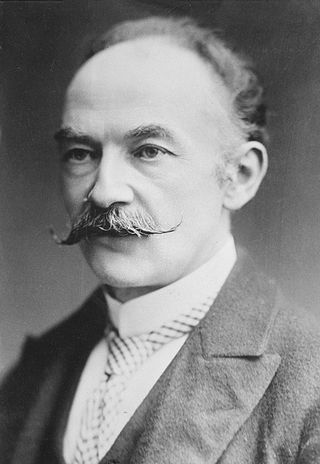
Thomas Hardy was an English novelist and poet. A Victorian realist in the tradition of George Eliot, he was influenced both in his novels and in his poetry by Romanticism, including the poetry of William Wordsworth. He was highly critical of much in Victorian society, especially on the declining status of rural people in Britain, such as those from his native South West England.
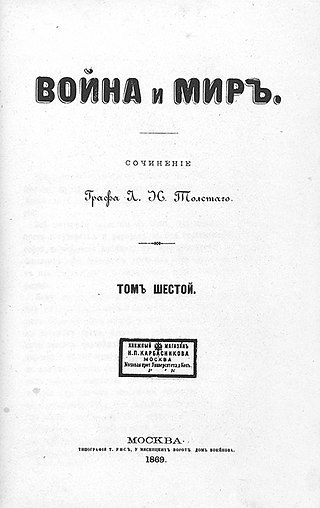
War and Peace is a literary work by Russian author Leo Tolstoy. Set during the Napoleonic Wars, the work mixes fictional narrative with chapters on history and philosophy. First published serially beginning in 1865, the work was rewritten and published in its entirety in 1869. It is regarded as Tolstoy's finest literary achievement and remains an internationally praised classic of world literature.
Boxer is a character from George Orwell's 1945 novel Animal Farm. He is shown as the farm's dedicated and loyal laborer. Boxer serves as an allegory for the Russian working-class who helped to oust Tsar Nicholas and establish the Soviet Union, but were eventually betrayed by the government under Joseph Stalin.
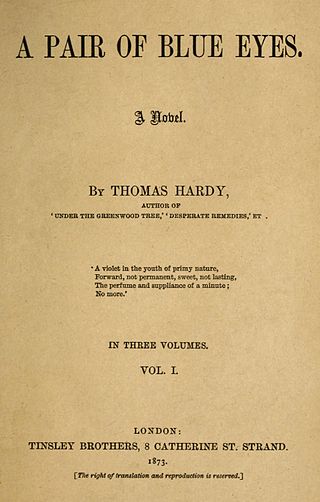
A Pair of Blue Eyes is a novel by Thomas Hardy, published in 1873, first serialised between September 1872 and July 1873. It was Hardy's third published novel, and the first not published anonymously upon its first publication. Hardy included it with his "romances and fantasies".
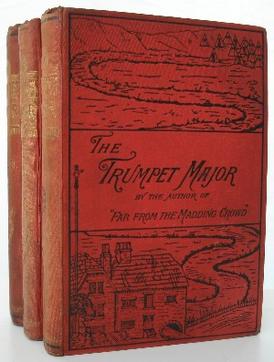
The Trumpet-Major is a novel by Thomas Hardy published in 1880, and his only historical novel, and Hardy included it with his "romances and fantasies". It concerns the heroine, Anne Garland, being pursued by three suitors: John Loveday, the eponymous trumpet major in a British regiment, honest and loyal; his brother Bob, a flighty sailor; and Festus Derriman, the cowardly nephew of the local squire. Unusually for a Hardy novel, the ending is not entirely tragic; however, there remains an ominous element in the probable fate of one of the main characters.

Undines are a category of elemental beings associated with water, stemming from the alchemical writings of Paracelsus. Later writers developed the undine into a water nymph in its own right, and it continues to live in modern literature and art through such adaptations as Danish Hans Christian Andersen's 1837 "The Little Mermaid" and the 1811 novella Undine by Friedrich de la Motte Fouqué.

War and Peace is a 1956 epic historical drama film based on Leo Tolstoy's 1869 novel of the same name. It is directed and co-written by King Vidor and produced by Dino De Laurentiis and Carlo Ponti for Paramount Pictures. The film stars Audrey Hepburn as Natasha, Henry Fonda as Pierre, and Mel Ferrer as Andrei, along with Oskar Homolka, Vittorio Gassman, Herbert Lom, Jeremy Brett, John Mills and Anita Ekberg in one of her first breakthrough roles. The musical score was composed by Nino Rota and conducted by Franco Ferrara.
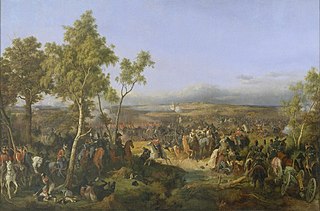
The Battle of Tarutino was a part of Napoleon's invasion of Russia. In the battle Russian troops under the command of Bennigsen defeated French troops under the command of Joachim Murat. The battle is sometimes called the Battle of Vinkovo or the Battle of Chernishnya after the local river. Many historians claim that the latter name is more fitting because the village of Tarutino was 8 km from the described events.
Peter Preston Brooks is an American literary theorist who is Sterling Professor Emeritus of Comparative Literature at Yale University and Andrew W. Mellon Scholar in the Department of Comparative Literature and the Center for Human Values at Princeton University. He has been Professor in the Department of English and School of Law at the University of Virginia. Among his many accomplishments is the founding of the Whitney Humanities Center at Yale University. He was elected to the American Philosophical Society in 2003. Brooks is an interdisciplinary scholar whose work cuts across French and English literature, law, and psychoanalysis. He was influenced by fellow Yale scholar, Paul de Man, to whom his book Reading for the Plot is dedicated. His 2022 book Seduced By Story was a finalist for the 2023 National Book Critics Circle award in criticism.

Animal Farm is a 1954 adult animated film directed by animators John Halas and Joy Batchelor. It was produced by Halas and Batchelor and funded in part by the Central Intelligence Agency (CIA), who also made changes to the original movie script. It was based on the 1945 novel of the same name by George Orwell. Although the film was a financial failure and took 15 years to generate a profit, it quickly became a staple in classrooms across the United Kingdom, the United States and other English-speaking countries like Australia, Canada, and New Zealand into the 1980s.
The weapon dance employs weapons—or stylized versions of weapons—traditionally used in combat in order to simulate, recall, or reenact combat or the moves of combat in the form of dance, usually for some ceremonial purpose. Such dancing is quite common to folk ritual on many parts of the world. Weapon dancing is certainly ancient; among the earliest historical references we have are those that refer to the pyrrhichios, a weapon dance in ancient Sparta, in which the dance was used as a kind of ritual training for battle.

Count Lev Nikolayevich Tolstoy, usually referred to in English as Leo Tolstoy, was a Russian writer who is regarded as one of the greatest authors of all time. He received nominations for the Nobel Prize in Literature every year from 1902 to 1906 and for the Nobel Peace Prize in 1901, 1902, and 1909; the fact that he never won is a major controversy.
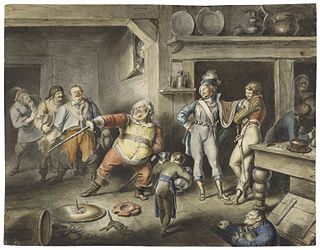
History is one of the three main genres in Western theatre alongside tragedy and comedy, although it originated, in its modern form, thousands of years later than the other primary genres. For this reason, it is often treated as a subset of tragedy. A play in this genre is known as a history play and is based on a historical narrative, often set in the medieval or early modern past. History emerged as a distinct genre from tragedy in Renaissance England. The best known examples of the genre are the history plays written by William Shakespeare, whose plays still serve to define the genre. History plays also appear elsewhere in British and Western literature, such as Thomas Heywood's Edward IV, Schiller's Mary Stuart or the Dutch play Gijsbrecht van Aemstel.
Adam Squire or Squier was an English churchman and academic, Master of Balliol College, Oxford, from 1571 to 1580, and Archdeacon of Middlesex from 1577.
Grace Mayer Frank was an American medievalist and lecturer. Frank, along with her spouse, the classicist Tenney Frank, was primarily associated with Bryn Mawr College, first as a graduate student, and later as a Lecturer and Associate Professor of Romance Philosophy and Old French. Beginning in 1919, Frank lived in Baltimore, Maryland, where she would reside for the majority of her life, serving also as a Visiting Professor of Romance Philology at Johns Hopkins University in that city.

The Dream of Ossian is an 1813 painting by the French artist Jean-Auguste-Dominique Ingres. The work depicts the legendary poet Ossian sleeping while he dreams of relatives, warriors, and maidens, which appear above him on the canvas. Ingres was influenced by his contemporaries' Ossianic works, including James Macpherson's purported translations of Ossian's poems, François Gérard's 1801 painting Ossian Evoking Phantoms, and Jean-François Le Sueur's 1803 opera Ossian, ou Les bardes.
Laura Alandis Hibbard Loomis was an American literary scholar and college professor who specialized in medieval English literature.

"Reflections on Gandhi" is an essay by George Orwell, first published in 1949, which responds to Mahatma Gandhi's autobiography The Story of My Experiments with Truth. The essay, which appeared in the American magazine Partisan Review, discusses the autobiography and offers both praise and criticism to Gandhi, focusing in particular on the effectiveness of Gandhian nonviolence and the tension between Gandhi's spiritual worldview and his political activities. One of a number of essays written by Orwell and published between Animal Farm (1945) and Nineteen Eighty-Four (1949), "Reflections on Gandhi" was the last of Orwell's essays to be published in his lifetime and was not republished until after his death.
Daisy Elna Sherman was a composer, musicologist, and teacher with a special interest in Thomas Hardy.
References
- 1 2 Hynes, Samuel (Spring 1994). "Mr. Hardy's Monster: Reflections on The Dynasts". The Sewanee Review. 102 (2): 213–232. JSTOR 27546849.
- ↑ Dickinson, Thomas H (April 1912). "Thomas Hardy's The Dynasts". The North American Review. 195 (677): 526–542. JSTOR 25119738.
- ↑ Orel, Harold, "Thomas Hardy's Epic-Drama: A Study of The Dynasts". University of Kansas Publications (Humanistic Studies No 36), Lawrence, Kansas, USA, 1963.
- ↑ Orwell, 'Thomas Hardy Looks at War' in Tribune , 18 September 1942
- ↑ Clifford, Emma (August 1956). "War and Peace and The Dynasts". Modern Philology. 54 (1): 33–44. doi:10.1086/389123. JSTOR 435156. S2CID 162233148.
- ↑ Wain, John, Introduction to The Dynasts by Thomas Hardy, St Martin's Press (Papermac), 1965 printing.
- ↑ Sherman, George Witter (1948). "The Influence of London on the Dynasts". PMLA. 63 (3): 1017–1028. doi:10.2307/459696. JSTOR 435156.
- ↑ Sherman, Elna (1940). "Thomas Hardy: Lyricist, Symphonist". Music & Letters. 21 (2): 143–171. doi:10.1093/ml/XXI.2.143. JSTOR 727177.
- ↑ Henchman, Anna (Autumn 2008). "Hardy's Stargazers and the Astronomy of Other Minds". Victorian Studies. 51 (1): 37–64. doi:10.2979/vic.2008.51.1.37. JSTOR 20537365. PMID 19618526. S2CID 6032618.
- ↑ Jones, Lawrence (Autumn 1975). "Thomas Hardy's "Idiosyncratic Mode of Regard"". ELH. 42 (3): 433–459. doi:10.2307/2872713. JSTOR 2872713.
- ↑ Bailey, J.O. (December 1946). "Hardy's "Mephistophelian Visitants"". PMLA. 61 (4): 1146–1184. doi:10.2307/459110. JSTOR 459110.